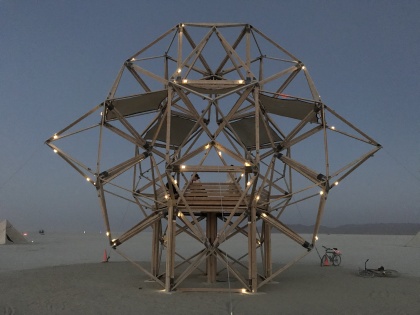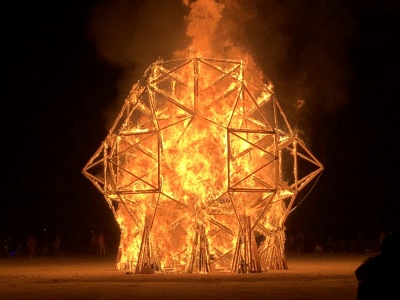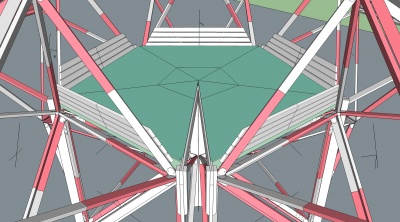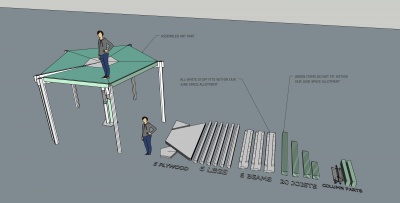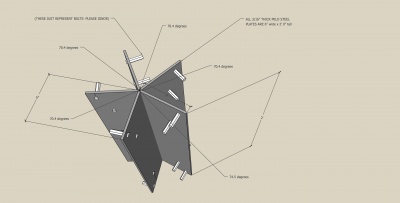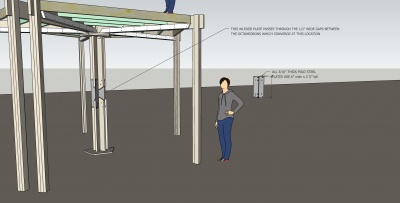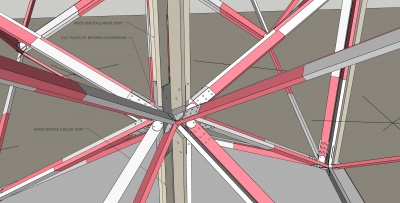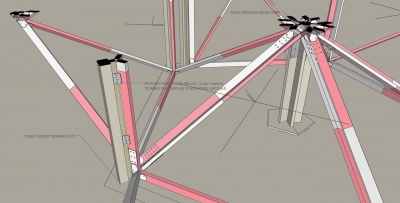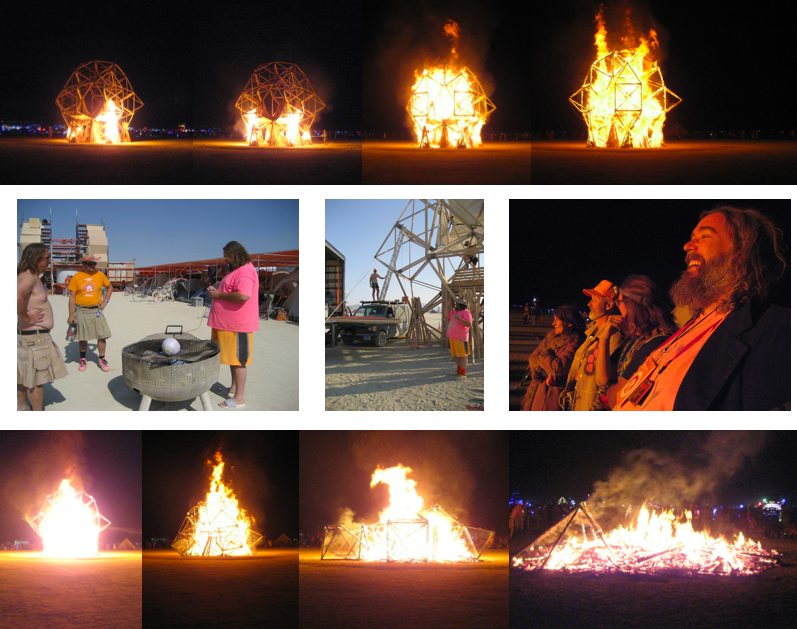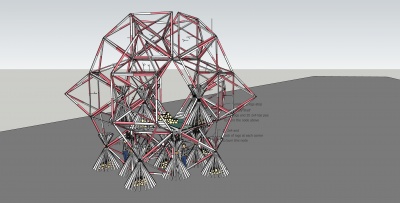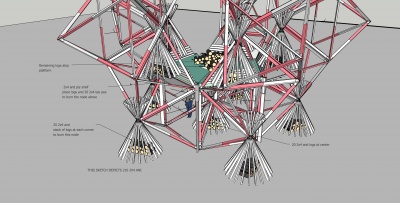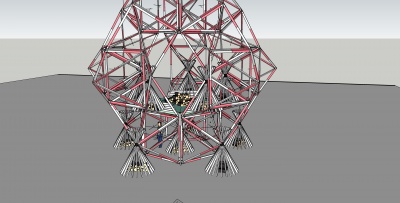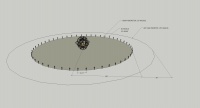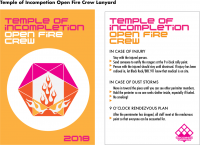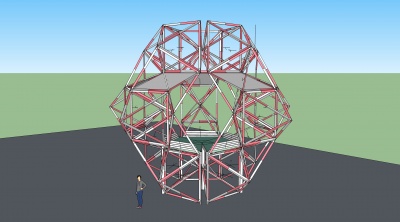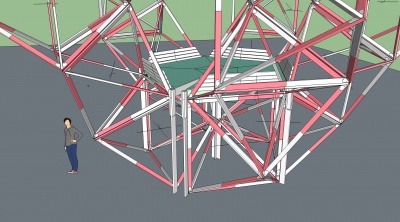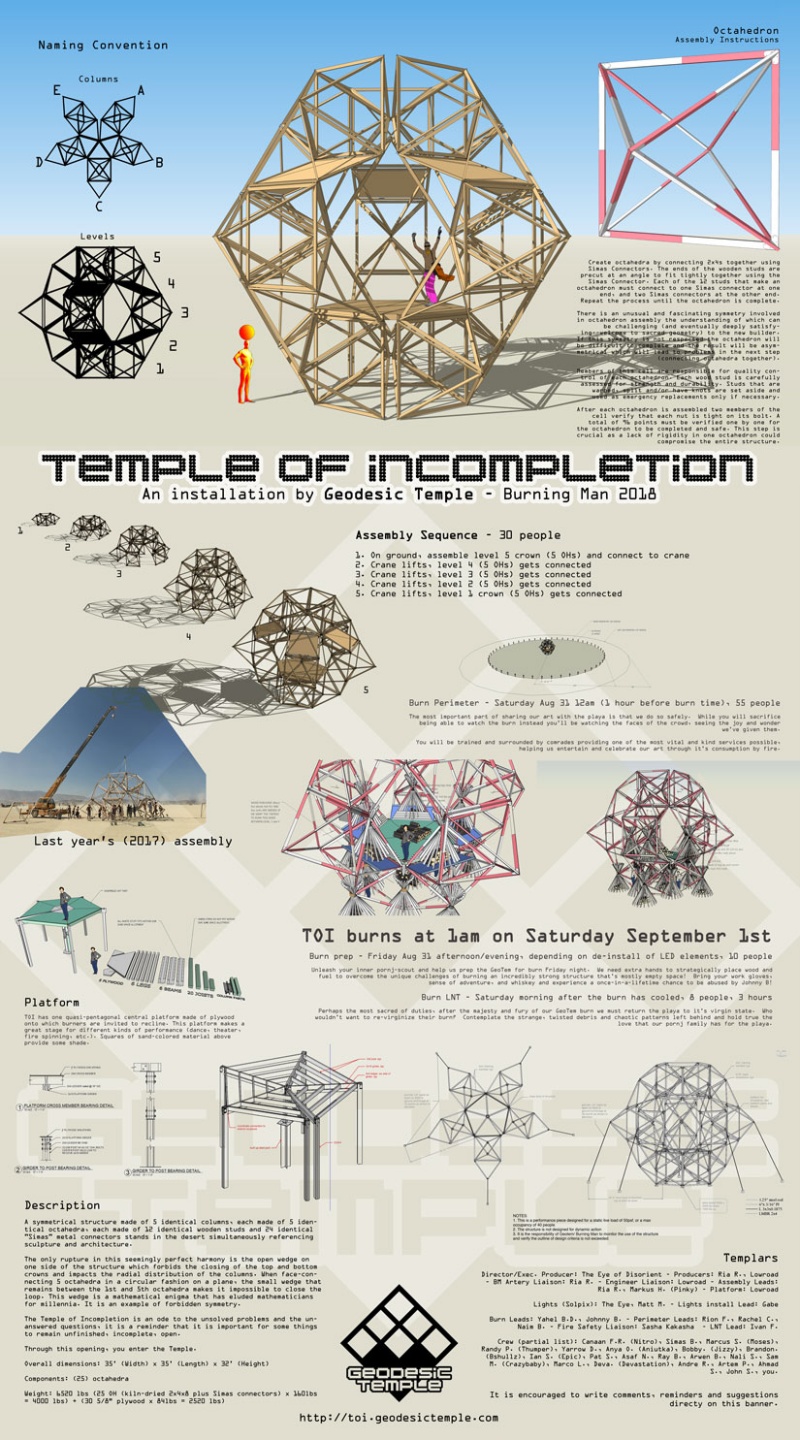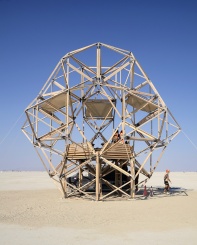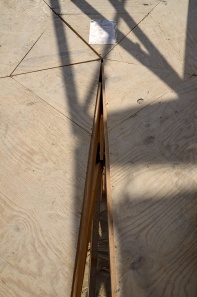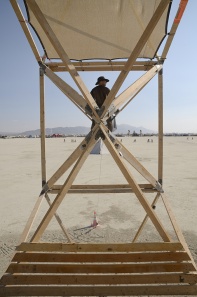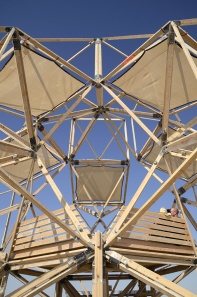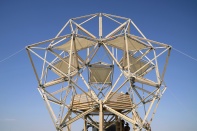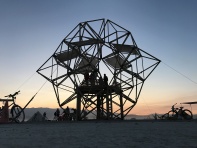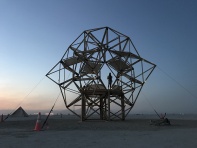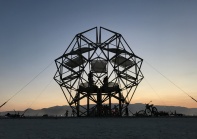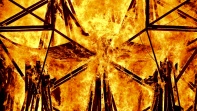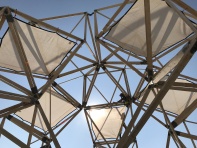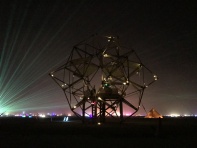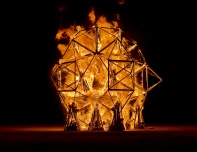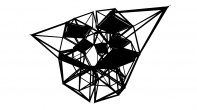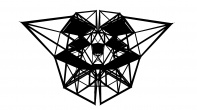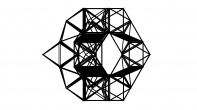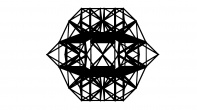Difference between revisions of "Temple of Incompletion"
(→Burn) |
(→Burn) |
||
| Line 53: | Line 53: | ||
[[File:GeoTem18-TimeLapse.png|800px]] | [[File:GeoTem18-TimeLapse.png|800px]] | ||
BURN PLAN<BR> | |||
The Geodesic temple design presents some unique challenges for burning as it is mostly empty space - tough to build concentrated heat. Additionally it is an exceptionally resilient structure - hard to collapse. We designed our burn with a couple of key goals in mind:<BR> | The Geodesic temple design presents some unique challenges for burning as it is mostly empty space - tough to build concentrated heat. Additionally it is an exceptionally resilient structure - hard to collapse. We designed our burn with a couple of key goals in mind:<BR> | ||
- It must be safe<BR> | - It must be safe<BR> | ||
| Line 63: | Line 62: | ||
<BR> | <BR> | ||
As Lowroad was fond of pointing out, "fire travels up". Looking at the structure we identified 6 vertical arcs the 2x4s of the structure made along which we would concentrate the fire. We would additionally place a fire around the center support for the platform as well as on top of the platform as there was an idea concentration of material for prolonged combustion.<BR> | As Lowroad was fond of pointing out, "fire travels up". Looking at the structure we identified 6 vertical arcs the 2x4s of the structure made along which we would concentrate the fire. We would additionally place a fire around the center support for the platform as well as on top of the platform as there was an idea concentration of material for prolonged combustion.<BR> | ||
[[File:TOI_BURN PLAN_v3.jpg|400px]] [[File:TOI_BURN PLAN_level 2 teepees.jpg|400px]] | [[File:TOI_BURN PLAN_v3.jpg|400px]] [[File:TOI_BURN PLAN_level 2 teepees.jpg|400px]] | ||
[[File:TOI_BURN PLAN_V1 DETAIL.jpg|400px]] [[File:TOI_BURN PLAN_v1.jpg|400px]] | [[File:TOI_BURN PLAN_V1 DETAIL.jpg|400px]] [[File:TOI_BURN PLAN_v1.jpg|400px]]<BR> | ||
<BR> | |||
WOOD PLACEMENT<BR> | |||
- The individual fires ended up being more "tee-pee"s than hourglasses and these were made out of 2x4s which were wired into place around the base and on the second level of the platform<BR> | - The individual fires ended up being more "tee-pee"s than hourglasses and these were made out of 2x4s which were wired into place around the base and on the second level of the platform<BR> | ||
- Ignition devices were placed inside the base of these fires, surrounded by small pieces of wood and kindling, then the entire structure was filled with firewood.<BR> | - Ignition devices were placed inside the base of these fires, surrounded by small pieces of wood and kindling, then the entire structure was filled with firewood.<BR> | ||
| Line 76: | Line 76: | ||
- We used plywood sheets to make a backstop on the second level where the fires could be build above the ones below<BR> | - We used plywood sheets to make a backstop on the second level where the fires could be build above the ones below<BR> | ||
ADDITIONAL FUEL<BR> | |||
The height of the structure presented some challenges. To try for our goal of a planned collapse we hoped to place some additional combustibles in the upper portions clustered around strategic points to weaken the structure. Additionally the vertices are joined using metal connectors (Lowroad, otherwise) which insulate and protect the wood from burning as quickly in the most structurally important points to weaken. If we could attach long burning combustibles around these spots we might be able to burn them more effectively.<BR> | The height of the structure presented some challenges. To try for our goal of a planned collapse we hoped to place some additional combustibles in the upper portions clustered around strategic points to weaken the structure. Additionally the vertices are joined using metal connectors (Lowroad, otherwise) which insulate and protect the wood from burning as quickly in the most structurally important points to weaken. If we could attach long burning combustibles around these spots we might be able to burn them more effectively.<BR> | ||
- Prior to our arrival on the playa we made wired wax and sawdust pucks which could be wired in place around the plywood, around/wrapped with a strip of burlap. | - Prior to our arrival on the playa we made wired wax and sawdust pucks which could be wired in place around the plywood, around/wrapped with a strip of burlap. | ||
| Line 86: | Line 86: | ||
I'm not sure how these effected the overall burn. In the end the structure did collapse as we'd hoped and in some photos you can see the fire burning in these concentrated points.<BR> | I'm not sure how these effected the overall burn. In the end the structure did collapse as we'd hoped and in some photos you can see the fire burning in these concentrated points.<BR> | ||
IGNITION PLAN<BR> | |||
- I had tested an ignition method using steel wool with current run across it - this is a great experiment and produces a wild, slow burning metal fire.<BR> | - I had tested an ignition method using steel wool with current run across it - this is a great experiment and produces a wild, slow burning metal fire.<BR> | ||
- These would be placed in paper lanterns which in turn would be filled with scrap paper, lint, and other burnables collected during the burn.<BR> | - These would be placed in paper lanterns which in turn would be filled with scrap paper, lint, and other burnables collected during the burn.<BR> | ||
| Line 93: | Line 93: | ||
<BR> | <BR> | ||
These didn't work great, probably for a number of reasons including running out of wire, poor wiring being knocked around as we added firewood, and insufficient voltage. Two of the spots ignited and then the backup road flares were eagerly lit and the rest of the structure ignited manually. Always have a backup...<BR> | These didn't work great, probably for a number of reasons including running out of wire, poor wiring being knocked around as we added firewood, and insufficient voltage. Two of the spots ignited and then the backup road flares were eagerly lit and the rest of the structure ignited manually. Always have a backup...<BR> | ||
FUEL<BR> | |||
The FAST team pushed back on the amount of fuel we wanted to use as we reported it on paper but in the end the actual FAST member who supervised our fueling did not seem overly concerned.<BR> | The FAST team pushed back on the amount of fuel we wanted to use as we reported it on paper but in the end the actual FAST member who supervised our fueling did not seem overly concerned.<BR> | ||
- I believe we used 12 gallons of diesel<BR> | - I believe we used 12 gallons of diesel<BR> | ||
- We filled a number of small bottles of fuel to be placed around the structure<BR> | - We filled a number of small bottles of fuel to be placed around the structure<BR> | ||
- The "tee pee" structure of the small fires allowed us to place fuel bottles at the base and at the top of these fires to aid in ignition<BR> | - The "tee pee" structure of the small fires allowed us to place fuel bottles at the base and at the top of these fires to aid in ignition<BR> | ||
OTHER THOUGHTS<BR> | |||
- We had 3-4 powder fire extinguishers available, did we get a water one?<BR> | - We had 3-4 powder fire extinguishers available, did we get a water one?<BR> | ||
- The 2x4s were excellently seasoned. We should think about cycling 2x4s from projects for use as temples to be burnt so we can use playa seasoned wood as much as possible.<BR> | - The 2x4s were excellently seasoned. We should think about cycling 2x4s from projects for use as temples to be burnt so we can use playa seasoned wood as much as possible.<BR> | ||
Revision as of 21:19, 20 February 2019
a sculpture by Geodesic Temple at Burning Man 2018
Description
A symmetrical structure made of 5 identical columns, each made of 5 identical octahedra, each made of 12 identical wooden studs and 24 identical "Simas" metal connectors stands in the desert simultaneously referencing sculpture and architecture. The Temple of Incompletion is an evolution of the Temple of Forbidden Symmetry, Geodesic Temple's installation at Burning Man 2017.
The only rupture in this seemingly perfect harmony is the open wedge on one side of the structure which forbids the closing of the top and bottom crowns and impacts the radial distribution of the columns. When face-connecting 5 octahedra in a circular fashion on a plane, the small wedge that remains between the 1st and 5th octahedra makes it impossible to close the loop. This wedge is a mathematical enigma that has eluded mathematicians for millennia. It is an example of forbidden symmetry.
The Temple of Incompletion is an ode to unsolved problems and unanswered questions, it is a reminder that it is sometimes important for things to remain unfinished, incomplete, open, and let the journey become the destination.
It is through this opening that you can enter the Temple.
Measurements
Overall dimensions: 35' (Width) x 35' (Length) x 32' (Height)
Components: (25) octahedra
Weight: 6520 lbs (25 OH (kiln-dried 2x4x8 plus Simas connectors) x 160lbs = 4000 lbs) + (30 5/8” plywood x 84lbs = 2520 lbs)
Templars
Director/Exec. Producer: The Eye of Disorient
Producers: Ria R., Lowroad
BM Artery Liaison: Ria R.
Engineer Liaison: Lowroad
Assembly Leads: Ria R., Markus H. (Pinky)
Platform: Lowroad
Lights plan A (Solpix): The Eye, Matt M.
Lights plan A install Lead: Gabe
Lights plan B (LED pars): Vadim
Burn Leads: Yahel B.D., Johnny B.
Perimeter Leads: Rion F. , Rachel C. , Naim B.
Fire Safety Liaison: Sasha Kakasha
LNT Lead: Ivan F.
Tight Crew: Canaan F.R. (Nitro) , Simas B. , Marcus S. (Moses) , Randy P. (Thumper) , Yarrow D. , Anya O. (Aniutka) , Bobby. (Jizzy) , Brandon. (Bshullz) , Ian S. (Epic) , Pat S. , Asaf N. , Ray B. , Arwen B. , Nali S. , Sam M. (Crazybaby) , Marco L. , Deva. (Devastation) , Andre R. , Artem P. , Ahmad S. , John S. , you.
Platform
TOI has one quasi-pentagonal central platform made of plywood onto which burners are invited to recline. This platform makes a great stage for different kinds of performance (dance, theater, fire spinning, etc.). Squares of sand-colored material above provide some shade.
Lights
At night one hundred and fifty individual white solar lights (Solpix) located near the nodes on the structure create a scintillating effect. Each Solpix is equipped with solar panel, battery, light sensor and 6 LEDs pointing in 2 directions. Each Solpix works independently. There is no physical connection between Solpixes and no external power is required to run the lights.
Burn
TOI burned at 1am Saturday September 1st, 2019.
The radius of the perimeter was 120' and required a crew of 55, that's 1 person every 15' plus 4 quadrant leads.
BURN PLAN
The Geodesic temple design presents some unique challenges for burning as it is mostly empty space - tough to build concentrated heat. Additionally it is an exceptionally resilient structure - hard to collapse. We designed our burn with a couple of key goals in mind:
- It must be safe
- The structure should completely burn
- It should burn fast, certainly not take all night
- It should be an aesthetically pleasing burn, ideally with simultaneous ignitions
- It should elegantly collapse inward upon itself, not fall over and need to be thrown/pushed back onto the central fire
As Lowroad was fond of pointing out, "fire travels up". Looking at the structure we identified 6 vertical arcs the 2x4s of the structure made along which we would concentrate the fire. We would additionally place a fire around the center support for the platform as well as on top of the platform as there was an idea concentration of material for prolonged combustion.
WOOD PLACEMENT
- The individual fires ended up being more "tee-pee"s than hourglasses and these were made out of 2x4s which were wired into place around the base and on the second level of the platform
- Ignition devices were placed inside the base of these fires, surrounded by small pieces of wood and kindling, then the entire structure was filled with firewood.
- The firewood was stacked in a similar pyramid fashion as much as space and wood shape would allow, all with the idea of driving the fire upwards.
- The top of the "tee-pees" allowed us to stack additional firewood upwards into the structure as a second concentration of fuel and heat.
- The added fuel consisted of 1.5 cords of firewood (mad props to the PDW crew for bringing it out!)
- We used 210 2x4s to build the smaller fires
- We used plywood sheets to make a backstop on the second level where the fires could be build above the ones below
ADDITIONAL FUEL
The height of the structure presented some challenges. To try for our goal of a planned collapse we hoped to place some additional combustibles in the upper portions clustered around strategic points to weaken the structure. Additionally the vertices are joined using metal connectors (Lowroad, otherwise) which insulate and protect the wood from burning as quickly in the most structurally important points to weaken. If we could attach long burning combustibles around these spots we might be able to burn them more effectively.
- Prior to our arrival on the playa we made wired wax and sawdust pucks which could be wired in place around the plywood, around/wrapped with a strip of burlap.
- These consisted of paper cups with a wire run through it sideways in a "u" shape, filled with sawdust, and then filled with melted wax.
- The wire was then cut at the U and the paper cup cut in half in the middle
- This essentially made "ear muffs" so the paper/wax/sawdust could be wired around the 2x4s
- We added strips of burlap to wrap around the pucks so ideally melting wax would be absorbed and heat/fire would be concentrated in these locations.
I'm not sure how these effected the overall burn. In the end the structure did collapse as we'd hoped and in some photos you can see the fire burning in these concentrated points.
IGNITION PLAN
- I had tested an ignition method using steel wool with current run across it - this is a great experiment and produces a wild, slow burning metal fire.
- These would be placed in paper lanterns which in turn would be filled with scrap paper, lint, and other burnables collected during the burn.
- They were wired together in parallel to a single point which I connected to a rechargeable battery
- As a fail safe, we duct taped two road flares to metal poles (extra ones from the shade structures) so that it could be lit manually
These didn't work great, probably for a number of reasons including running out of wire, poor wiring being knocked around as we added firewood, and insufficient voltage. Two of the spots ignited and then the backup road flares were eagerly lit and the rest of the structure ignited manually. Always have a backup...
FUEL
The FAST team pushed back on the amount of fuel we wanted to use as we reported it on paper but in the end the actual FAST member who supervised our fueling did not seem overly concerned.
- I believe we used 12 gallons of diesel
- We filled a number of small bottles of fuel to be placed around the structure
- The "tee pee" structure of the small fires allowed us to place fuel bottles at the base and at the top of these fires to aid in ignition
OTHER THOUGHTS
- We had 3-4 powder fire extinguishers available, did we get a water one?
- The 2x4s were excellently seasoned. We should think about cycling 2x4s from projects for use as temples to be burnt so we can use playa seasoned wood as much as possible.
- The FAST team shut down the idea of sawdust fireballs as they are moopy and usually poorly executed (though maybe I've earned a little credit from them)
Home Depot List
https://docs.google.com/spreadsheets/d/198lZvL9-O-Mqpl9za4XReo2zbbfhjPJNcbOT-fOT0rc/edit#gid=0
Notes
Assembly sequence: Top-down (similar to geodesic dome) using crane (see assembly sequence drawing)
3D model: TempleOfIncompletion20180119.skp
Animation: TBA
Reference: Forbidden crystal symmetry in mathematics and architecture
